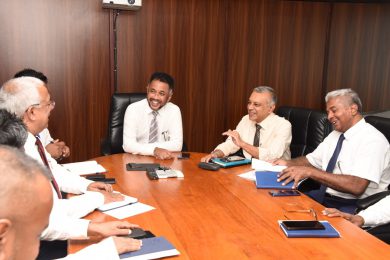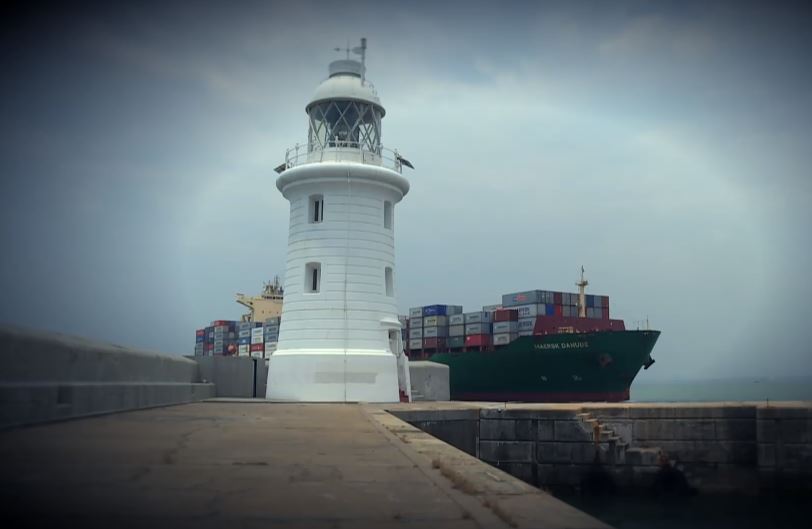Due to limitations of the restricted water basin size and water depth in the existing port which was built over 130 years ago during the British rule, it became necessary to build a new water basin larger in size and with deeper water depth protected by breakwaters called South Harbor.
by D. Godage
Colombo Port needs further expansion to handle container traffic is the topic of a report published recently based on a statement by the Chief Delegate of the German Industry and Commerce at a conference in Colombo.
Colombo Port has earned the status as hub port in the South Asian region primarily due to its strategic location in the Indian Ocean connecting the Middle East with the Far East as the gateway to South Asia. To cater to the increasing demand for services in international shipping and to accommodate modern mega container ships that are in operation the Colombo South Harbor became the latest addition to the Colombo Port.
Due to limitations of the restricted water basin size and water depth in the existing port which was built over 130 years ago during the British rule, it became necessary to build a new water basin larger in size and with deeper water depth protected by breakwaters called South Harbor.
This necessity of new harbor basin was recognized in 1995 when public invitations were called by the Ports Authority from private investors to build a new breakwater and container terminals located to the west of the existing harbor at the southern end hence named South Harbor. It was intended to attract and accommodate the most modern mega container ships.
The South Asia Gateway Terminal (SAGT) is the result of above stated exercise from 1999 but the new harbor concept got delayed. The Asian Development Bank (ADB) came forward to conduct a feasibility study on grant assistance followed up by a Technical Assistance loan in 2001 to the Ports Ministry to conduct detailed engineering designs and all other documents required to implement the project. All these prerequisites were completed in 2005 but the project stagnated thereafter due to non-availability of large amount of funds required to construct the massive new breakwater.
Approaches by the government for funds required to implement the project were a failure for about two years until the Asian Development Bank came forward with a major capital development soft loan of US$ 300 million. This is a noteworthy and fortunate milestone of this important national project. The Loan Agreement was signed in April 2007.
An open, competitive and transparent tender process followed resulting in the selection of a competent contractor who completed the construction of port infrastructure including a six-km long massive breakwater and dredging on time and within the budget. The project was completed on time in April 2012 utilizing the US$ 300 million loan plus the Ports Authority contribution of equivalent US$ 100 million counterpart funds.
This new harbor basin is around 285 hectares in extent at 18 meters water depth and entrance channel at 20 m water depth. This harbor is designed to accommodate three large container terminals on its three sides South, East and West each with designed capacity of 2.4 million TEUs (container units) per year. For those not familiar with geography of the Port the map below is attached. South Terminal has been operational since 2012 under Colombo International Container Terminals Limited (CICT) handling 2.9 million TEUs in 2019 exceeding designed capacity. East and West terminals are not operational yet.
Port Performance
Colombo Port has been undergoing systematic expansion of container handling facilities except on two occasions, one from 1988 to 1992 when the volume handled stagnated around 600,000 TEUs and the other from 1997 to 2002 when the volume stagnated at near 1.7 million TEUs. There were ship diversions, by-passing Colombo and congestion. Lloyd`s List reported in 1998 that all is not well with Colombo and steadily losing container traffic to Singapore and other ports. Fairplay magazine reported in 2001 that Colombo`s hub status has been under threat and losing traffic but had ignored customer requests to improve infrastructure and services.
We are now in a similar situation when in 2016 we handled 5.73 million TEUs, 6.2 million TEUs in 2017, 7 million TEUs in 2018 and 7.23 million TEUs in 2019 thereby exceeding estimated available capacity in the port.
Future of ECT
Detailed studies of Colombo South Harbor in 2005 announced South Terminal (CICT) to be fully operational by 2010 and next Terminal (ECT) fully operational by 2019. CICT was operational from 2012 whereas ECT operation is not in sight. It is noted that the government before 2015 had built part of the works and ordered the cranes and equipment costing around US$ 100 million. But the next government in 2015 canceled those orders during their time with three different Ministers at different times who failed to proceed causing great loss running into several billions of rupees. Even today ECT is not operating.
The newly presented National Port Master Plan of March 2019 states that capacity shortage starts from 2020, ECT should have been operational in 2019 but it did not happen.
The present government has halted development projects due to budget constraints but policy issues and preparatory matters should not be stopped to make use of the valuable time without wasting it. If the Ports Authority is to implement the project and if the green light is given today, it would take minimum 18 months to operate the partly built Terminal. Full Commissioning the whole ECT will take two more years noting the required investment of around US$ 500million.
Conclusion
Those in the maritime industry and others who wished the success of the Colombo Port highlighted for some years the urgency to operate the ECT. It is essential to decide on the methodology – whether there will be private participation or only state investment – and proceed fast. There were talks between Japan, India and the Ports Authority for joint action. Unless the ECT operation is accelerated, Colombo Port faces the inevitable danger of losing cargo volumes and global position in terms of connectivity. Prompt action is therefore awaited to operate ECT as the second deep water terminal.
( The writer is a Chartered Engineer, former Chief Engineer (Ports), Managing Director Sri Lanka Ports Authority and Project Director Colombo South Harbor Development Project. He is now retired but keeps in touch with port developments. Views expressed in this article are the author’s own)























